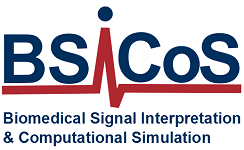18 September, 2024
The annual conference took place in the German city of Karlsruhe from September 8 to 11. Find here the works presented there:

Maxi Rosales: Design of Engineered Heart Tissues to Minimize Arrhythmic Risk After Implantation in Infarcted Hearts
Implantation of engineered heart tissues (EHTs) built from human induced pluripotent stem cell-derived cardiomyocytes (hiPSC-CMs) may restore cardiac function after myocardial infarction (MI). However, this might entail high arrhythmic risk due to poor electrical coupling and cellular organization in the EHTs.
We used an in silico porcine-specific biventricular (BiV) model of MI with an engrafted EHT and we assessed the impact of the EHT electrical conductivity (EHTc) (10%, 50% and 90% of that in healthy myocardium) and the hiPSC-CM alignment (EHTal) (random, parallel and perpendicular to the nearby epicardium) on the electrophysiological properties of the coupled BiV-EHT model.
Results showed that the action potential duration (APD) in the EHT was largely driven by the APD in the host tissue, especially for the highest EHTc. Besides, higher EHTc values led to lower repolarization time gradients (RTGs) in the coupled BiV-EHT model, thus implying lower arrhythmic risk. In mean for all tested EHTal cases, the maximum RTG was reduced by 72.4 ms/mm when EHTc was increased from 10% to 90%. Varying EHTal had minor electrophysiological effects on the engrafted EHT.
In conclusion, proarrhythmicity after EHT engraftment on infarcted ventricles highly depends on EHTc while EHTal plays a negligible role.
Leo Bueno: Implications of IUGR-Related Geometric Heart Changes on the ECG and Electrophysiology: an in silico perspective
This study aimed to simulate the geometric changes resulting from intrauterine growth restriction (IUGR) in a realistic biventricular heart model and assess their impact on cardiac electrophysiology. Geometric alterations were based on echocardiography measurements from IUGR patients. The model exhibited a reduction in left ventricle sphericity index and an increase in left ventricular wall thickness. Results showed a significant prolongation of the
QRS complex duration and an increase in R-wave magnitude when compared to control geometry, consistent with clinical findings. However, a modest increase in the Tpe interval, which aligns with clinical observations, is observed, while the QT interval shows a prolongation that contradicts clinical results. These findings suggest that while the simulated geometric changes reproduce certain clinical observations, others are not reproduced suggesting additional factors, such as changes in electrical activation and/or ionic remodeling influencing cardiac electrophysiology in IUGR, to be tested in future investigations
Javier Orera: Combined estimation of cross-sectional area, flow rate and Pulse Wave Velocity using Physics-Informed Neural Networks with 1D hemodynamic model data
The characterization of blood flow dynamics inside human vessels is essential for the personalised prediction and monitoring of cardio-vascular risk. However, accuracy is limited by the difficulty in the estimation of parameters of clinical relevance such as the Pulse Wave Velocity (PWV).
The aim of this work is to use Physics-Informed Neural Networks (PINNs) to simultaneously predict the propagation of nonlinear cross-sectional area and flow rate waves inside arterial vessels as well as to estimate the PWV using a cost-effective PINN-based one-dimensional (1D) blood flow model (Figure 1).
We use a first-order finite-volume Riemann solver to compute the ground truth solution of cross-sectional area a(x, t), flow rate q(x, t) and pressure p(x, t) inside an elastic artery, given a predefined value of the PWV.
We then developed a PINN using initial, boundary and vessel midpoint data to estimate the real value of PWV, as well as area and flow rate values. Regarding the neural network hyper parameter selection, we choose α = 0.001 for the Adam optimizer and 10 layers of 10 neurons each with activation function tanh.
Results reveal that, when departing from in-silico data derived from the 1D hemodynamic model, highly precise estimates of the PWV (errors of 4% ± 2.5%) and accurate area and flow rate wave propagation predictions (errors of ±2%) can be obtained.
We conclude that using only blood flow velocity data pertaining exclusively to one virtual single sensor affixed to the vessel’s midpoint, it is possible to obtain accurate estimates of the PWV, as opposed to previous approaches that require extensive 3D flow simulation data and the prior knowledge of the PWV.
Ángela Hernández: Sudden Cardiac Death Prediction in Chagas Heart Disease Patients from ECG-derived Biomarkers of Ventricular Restitution
Chagas heart disease (ChHD) is strongly linked to sudden cardiac death (SCD). The Rassi score is currently the only used clinical score with a strong association with mortality, but it lacks specificity when identifying individuals at risk of SCD. Ventricular restitution dynamics, a key factor in SCD occurrence, are difficult to assess on a large scale due to invasiveness and cost. Therefore, this study aims to develop ECG-based indices for ventricular restitution and evaluate their correlation with SCD risk in ChHD patients.
We analyzed 24-hour ECG recordings from 140 ChHD patients, among whom 45 had the primary SCD endpoint within the follow-up period. We derived ECG restitution indices quantifying changes in QT and T-peak-to-end intervals (Tpe) with heart rate (∆αQT and ∆αTpe), as well as changes in the overall T-wave morphology (TMR), or Tpe morphology (T peMR). We then evaluated the association of these indices with SCD using survival analyses.
Upon comparison between SCD and non-SCD groups, significant differences in clinical variables were found for Rassi score (p < 0.0001), ∆αTpe (p < 0.001) and T peMR (p < 0.001). Univariate Cox analysis revealed that ∆αTpe > 0.036 and TpeMR > 0.021 outcomes were associated with SCD risk, with a hazard ratio (HR) of 2.54 (95% confidence interval [CI]: 1.93-6.48; p < 0.0001) and 3.33 (95% CI: 1.82-6.06; p < 0.0001), respectively. Multivariate Cox proportional hazard model was constructed by adjusting Rassi score and, as a result, ∆αTpe > 0.0269 and TpeMR > 0.021 showed a significant HR of 2.93 (p < 0.001) and 2.02 (p = 0.023), respectively.
This study demonstrates that ECG indices assessing latephase ventricular repolarization restitution serve as robust and independent predictors of SCD in ChHD. The fact that ∆αQT and TMR were not associated with SCD suggest that ChHD may have other effects on ventricular repolarization, manifested on the earlier part of the T-wave, which masks the arrhythmogenic substrate specifically linked to SCD.
Sara Artal: Mejora de la detección de fibrilación auricular paroxística mediante un modelo semisupervisado basado en señales ECG
La fibrilación auricular (FA) es una de los principales contribuyentes a la muerte cardiovascular. En sus fases iniciales, esta patología aparece de forma intermitente, dando lugar a la fibrilación auricular paroxística (FAP), lo que dificulta su diagnóstico. El electrocardiograma (ECG) es una herramienta de diagnóstico ideal para la detección precoz de esta afección. Recientemente, las redes neuronales (RN) han sido empleadas en el ámbito de la cardiología para la predicción del riesgo cardíaco, sin embargo, su uso se encuentra limitado debido a la escasez de señales ECG etiquetadas disponibles y la baja incidencia de riesgo.
El objetivo de este trabajo es comprobar si el preentrenamiento, a partir de datos ECG genéricos sin costes de etiquetado, es capaz de mejorar el rendimiento de una RN en una tarea de aprendizaje supervisado para el diagnóstico de FAP, en la que los datos de entrenamiento son escasos y la proporción de casos se encuentra desbalanceada.
En primer lugar, se descargaron y preprocesaron conjuntos de datos de ECG disponibles públicamente, lo que dio como resultado un total de 1.602.185 señales ECG. A continuación, se implementó una red neuronal convolucional multicapa (CNN) y se entrenó de manera supervisada para el diagnóstico de FAP. El siguiente paso consistió en el desarrollo de un modelo de RN no supervisado con una arquitectura óptima, en este caso, basada en un modelo de codificación predictiva, conocido como CPC (Contrastive Predictive Coding).
Tanto los modelos supervisados como los semisupervisados mostraron un buen desempeño. Mediante el uso de una CNN simplificada, junto con una RN preentrenada de manera no supervisada, la precisión mejoró de 0,565 a 0,680, el área bajo la curva ROC (AUC) aumentó de 0,692 a 0,714 y la especificidad, para una sensibilidad de 0,750, creció de 0,534 a 0,579. Nuestros hallazgos respaldan que el método de aprendizaje semisupervisado es capaz de mejorar el rendimiento y simplificar la arquitectura y el entrenamiento del modelo de aprendizaje supervisado.
Neurys Gómez: Dynamics of T-peak-to-T-end Morphology Changes in an Open-chest Porcine Model, and its Relation to Arrhythmic Events
In this work, we use a time-warping-based morphology variation index, d_(w,T_pe)^PCA, computed between the peak and the end of the T-wave, and assess its association with the occurrence of ventricular fibrillation (VF) episodes (VF group) in ECG recordings from 20 pigs undergoing a 40-minute coronary occlusion. The d_(w,T_pe)^PCA series was obtained by quantifying the morphological differences between the final part of the T wave at different stages of the occlusion and that of a reference T wave from a control recording.
During occlusion, the absolute value of d_(w,T_pe)^PCA followed a gradual increasing trend as ischemia progressed. At 0-5, 5-10, 10-15 and 15-20 minutes after the occlusion onset, d_(w,T_pe)^PCA median values were significantly higher in the VF group than in the non-VF group (10.2, 11.7, 18.2 and 19.0 vs 1.8, 2.4, 3.2 and 2.4 ms), with p-values from the Kruskal-Wallis test of 0.017, 0.041, 0.045 and 0.013, respectively. In contrast, the T_pe index did not present significant differences in any of the intervals between VF and non-VF groups.
In conclusion, dynamic increases of the d_(w,T_pe)^PCA index during ischaemia progression in pigs are associated with VF occurrence.
Josseline Madrid: ECG Based Unsupervised Clustering Model Predicts Heart Failure and Cardiovascular Diseases in Individuals without Cardiovascular Disease
Early detection of cardiovascular risk in the general population is still a challenge. The electrocardiogram (ECG) is a cost-effective screening test for large populations. We hypothesize that individuals without known cardiovascular diseases (CVD) but with higher CVD risk might share similar ECG features that can be used for non-invasive risk stratification. This study aimed to identify distinct clusters of individuals without prevalent CVDs based on their ECG morphology using unsupervised machine learning and investigate their association with incident CVD risk.
A median heartbeat was derived from 10-seconds and 12-lead resting ECGs from 56,251 individuals without prevalent CVDs in the UK Biobank study. 22 ECG parameters related to time intervals, amplitudes, and morphology were calculated for each lead’s median heartbeat. Using k-means clustering, individuals were classified into k distinct clusters. Survival analysis assessed the association of each cluster with incident CVDs (4-years follow-up).
The model distinguished 2 clusters with varying morphological features, which significantly differed in terms of heart failure (HF) and CVDs rate. Cluster 2 (N = 25,097) included the highest rate of HF (0.53%, p<0.001) and CVDs (4.16%, p<0.001). These individuals exhibited wider QRS duration, longer QTc and Tpec intervals, flatter upward slopes and greater T wave morphological variations with respect to cluster 1.
Our analysis has identified in an unsupervised manner a group of individuals at risk of HF and CVDs using 10-second ECGs enabling fast and noninvasive risk assessment in large apparently healthy populations.
Alba Martín: The MUSIC Database: Sudden Cardiac Death in Heart Failure Patients
The MUSIC study is a prospective, multicenter study designed with the aim of developing prognostic models for sudden cardiac and total mortality in mild-to-moderate chronic heart failure (CHF). The database, now made available at Physionet, includes a total of 992 consecutive patients with symptomatic CHF corresponding to New York Heart Association (NYHA) classes II and III.
All patients had a 24-hour, 3-lead Holter ECG recorded at enrollment, plus available demographic and relevant clinical data. Primary outcomes were cardiac death, either sudden cardiac death (SCD) or pump failure death (PFD) at the end of the 4-year follow-up.
For further information: https://www.cinc2024.org/
